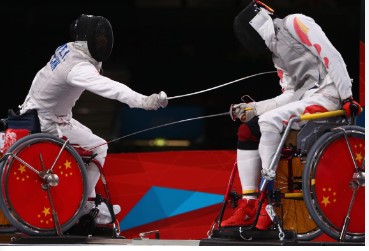Wheelchair Fencing Innovation Breaks Down Barriers to the Sport
A team of undergraduates from Imperial College has created a revolutionary low-cost design for a wheelchair fencing frame, aiming to make the sport accessible to people worldwide. Camille Morand-Duval, Josephine Latreille, and Leah Pattinson collaborated with the International Wheelchair & Amputee Sports Federation (IWAS) to develop this innovative project.
Wheelchair fencing requires athletes’ wheelchairs to be anchored to the ground using a specialized frame, but the high cost of these frames has been a significant barrier for many aspiring fencers. The team, supervised by Dr. Ian Radcliffe from the Department of Bioengineering, secured a grant from IWAS to create a more affordable frame using inexpensive, readily available materials that can be assembled with simple tools.
The students worked closely with Dimitri Coutya, a double Wheelchair Fencing World Champion, to test and refine their prototype. Their final design, along with instructions on how to build it, has been made freely available online by IWAS, enabling clubs and athletes globally to access and utilize this resource.
Josephine Latreille emphasized the importance of accessibility in sports: “We believe that anyone who wants to participate in sport should have the opportunity to do so. But a lack of proper equipment can create obstacles.” Highlighting the cost barriers, she noted that traditional wheelchair fencing frames can cost thousands of pounds, putting them out of reach for many, especially in developing countries.
To address these challenges, the team designed a frame that could be replicated with basic tools and no specialist knowledge. Camille Morand-Duval explained their approach: “We used materials that are simple to get hold of, or which could be easily substituted for what people might have lying around – such as car parts.”
In their research, the team consulted clubs in South Africa, India, and Uruguay to understand diverse needs. This feedback led them to create a modular design, allowing parts of the frame to be replaced, modified, or upgraded as needed. The frame was also designed to be lightweight and compact for easy transportation to competitions, a crucial factor for clubs.
Leah Pattinson highlighted the adaptability of their design: “Everyone is different, and the frame had to be able to adapt to lots of different needs.” This flexibility ensures that the frame can cater to a wide range of athletes and circumstances.
Charmaine Hooper, IWAS CEO, expressed the organization’s support for the initiative: “The cost of a wheelchair fencing frame can often pose a challenge to athletes, clubs, or coaches just getting into the sport. By delivering these free resources, IWAS hopes to provide an alternative option that will help to eliminate this obstacle and make the sport more accessible for all.”
This groundbreaking project by Imperial College students not only showcases innovation in sports engineering but also embodies the spirit of inclusivity and accessibility, breaking down barriers for wheelchair athletes around the world.



